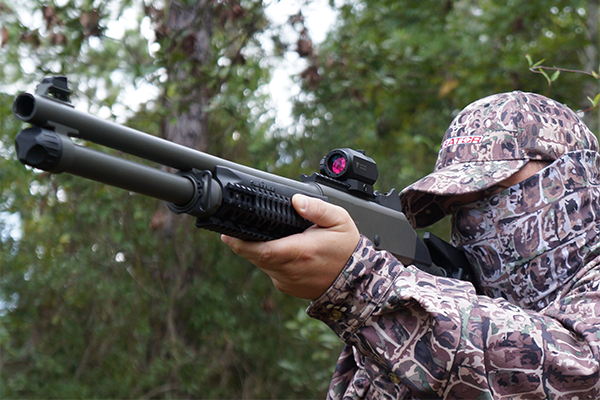
Last Updated on
This year’s outdoor and firearms “industry only” SHOT SHOW hosted by the NSSF in Las Vegas was certainly a big event for the folks at Nikon Optics. The show saw the unveiling of pre-production models of several additions to Nikon’s P-Tactical series. Included in these new upcoming releases was a compact, traditional tube-style red dot called the SuperDot with a 2 MOA reticle. This optic, along with another new upcoming release, the Nikon SPUR (Open glass design), would be the company’s first ventures into the rapidly growing red dot market.
These new releases gathered quite a bit of fan fare during the show and prompted several table top reviews from so called “experts” that ended up being nothing more that speculation due to not have available models to actually test. Only patience and a little bit of luck getting the first production run of some of the units for review would be the best way to really let readers know for sure if these optics were real deal hardware or just marketing hype in a good-looking package. After waiting a few months for the release of these products, packages finally started to arrive at our door for testing. This week, I take a look at the Nikon Super Dot and see how it stacks up with others on the market.
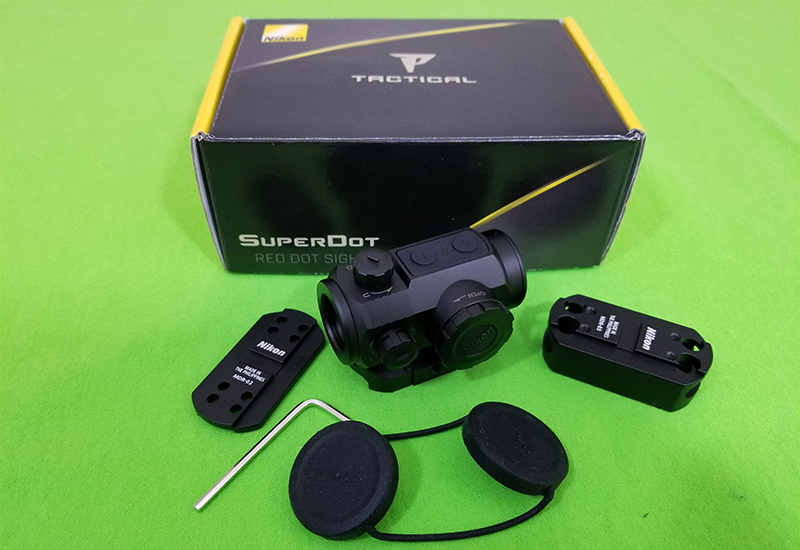
Nikon P-Tactical SuperDot First Impressions
The Nikon SuperDot arrived at my office in a P-Tactical series black and yellow cardboard box with SUPER DOT RED DOT SIGHT clearly printed on the side. Inside the box along with the SuperDot were the CR2032 Lithium Battery which is needed to power the unit, a Nikon branded lens cloth, Allen wrench, instruction booklet, rubber lens protectors, and three height specific mounting options and screws with the base mount already secured to the optic. This mount was designed for the industry standard Picatinny rail found on most firearms today.
The SuperDot was equipped with a 22mm sighting window for a wide field of view down range with a true 1x magnification. The sight window also offered an unlimited-and-non-critical eye relief for comfortably shooting with both eyes open. A great feature as with most Nikon products is the fact the SuperDot came with fully multicoated lenses and Nikon’s proprietary “TRUCOLOR” coating, which virtually eliminates the bluish tint associated with red dot sights. This is the down fall of many red dots when being used in low light by hunters, military and law enforcement alike by presenting the target in a darker tint than the exterior lighting conditions.
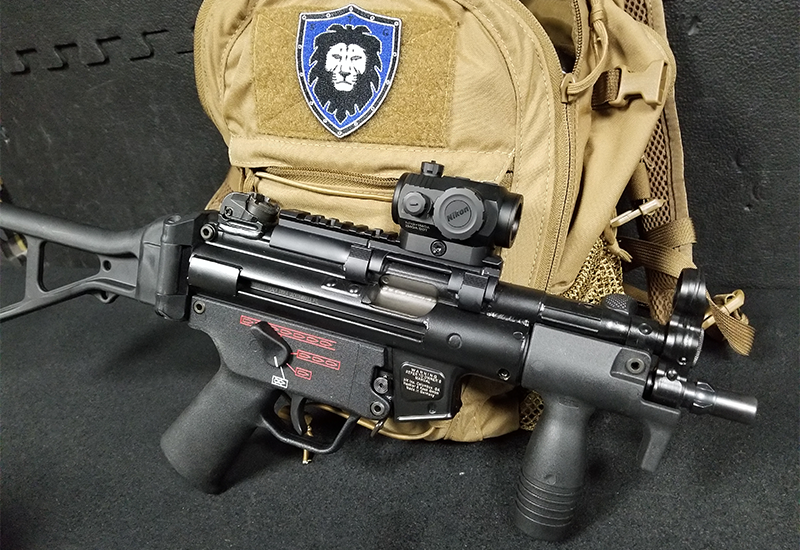
My earlier comment about the unit being compact was no understatement. The tube body measured only 2” in length and 1.7” in height. These measurements along with an overall weight of only 4.2 oz ensures the optic won’t affect the handling of most firearms. This is very important when adding the red dot to a firearm the shooter has trained extensively with. This only creates the need to train with orientation of the new reticle and operation.
After inspecting the red dot unit’s flush fit base mount along with 1/3 and full co-witness risers to add to the base mount, I could not decide which firearm I wanted to use for testing the Super Dot’s performance. The mounting and sighting options of the optics design left so many possibilities. Once I scheduled the range time for later that week, I decided to pack an assortment of rifles and shotguns as well as needed tools for removing existing mounts and installing the test optic. After all this was done, I headed out for some quality range time to fully explore the Nikon’s versatility.
SPECS
- Magnification: 1x
- Height: 1.7”
- Length: 2.8”
- Weight: 4.2 oz
- Dot Size: 2 MOA
- Dot Color: Red
- Adjustment Graduation: 1 click = 1 MOA
- Elevation Adjustment: Range 100 MOA
- Windage Adjustment: Range 100 MOA
- Power Source: CR2032 Lithium Battery
- Estimated Battery Life: 14,000 Hours
- Brightness Settings: Night Vision Compatible)
- MSRP: $199
Range Time
For the arduous task of testing the SuperDot with multiple firearms, evaluations would be done on both local indoor and outdoor ranges to evaluate lighting conditions and performance at close and long range. First up, I headed to Orange Park, FL to start things off at On Target Sports. I first mounted the SuperDot on top of my HK SP5K SBR 9mm. A quick lesson learned during this process was if you mount the optic too far forward, it interferes with being able to slap the charging handle down into battery. (YES, I use the much-debated HK “slap” method. Not only do I slap it, but I do so as if the company owned me money. According to HK, it was intended to be quickly knocked out of lock up using gross motor skills to prevent drag and ensure a full sling shot motion. I fully abided by their rationale.) By mounting the optic closer to the rear sight, I was clear of the charging handle.
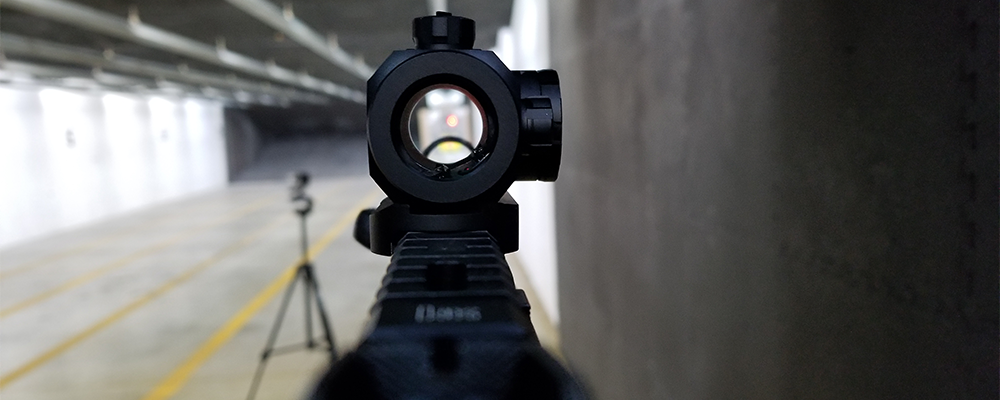
The SuperDot offers a 10-level intensity adjustment with the first two being night vision compatible. I found the best setting for the red dot was around the 4th level. It was easy to see and reacquire after each shot without being too bright and losing focus of the target. This setting would remain throughout the indoor testing on all firearms used. The 2 MOA dot seemed to be perfect for catching my eye quickly while still feeling like I could focus my shots into tight groups.
SP5K / MP5 Platform
When sighting the SuperDot in, I noticed two separate issues. The first being the optic’s height positioned it well above the factory irons thus preventing them from being able to co-witness the dot. Secondly, the HK front sight ring partially obstructed my view of the target area when sighting in through the red dot. Both did not prevent the optic from working as designed but did help me decided it was not the best choice for the SP5K / MP5 platform.
AK-47 Platform
Moving on to the AK-47, I mounted the SuperDot on the Troy Picatinny rail forward of the rifle’s action. This short barreled Krink-style NPAP in 7.62×39 has always been a smooth operating rifle but tough on optics due to its recoil and heat directly under the red dot. Again, the optic did not co-witness but at least it did not have any obstructions in my line of sight. As I fired round after round, I loved the feel of the rifle as it barked fire out of is short barrel and shook the red dot violently. By the end of the test session with the AK, the SuperDot’s point of aim / point of impact were still the very same. The optics’ design helped me focus forward onto target better than an open design would have and didn’t allow me to be distracted by items left or right of the rifle.
FN PS90 Platform
Switching over to one of my more unique rifles, the FN PS90 chambered in the 5.7mm round, the SuperDot seemed right at home. The tall Picatinny rail spanning across the rifle’s 50 round magazine offered plenty of room for the optic to mount. Due to the small overall size of the rifle, I typically use more of a center of body hold rather than shouldering the FN to facilitate moving around barriers left and right easier. The SuperDot’s 22 mm sighting window made it very easy to shoot with both eyes open and still see unobstructed at the targets down range.
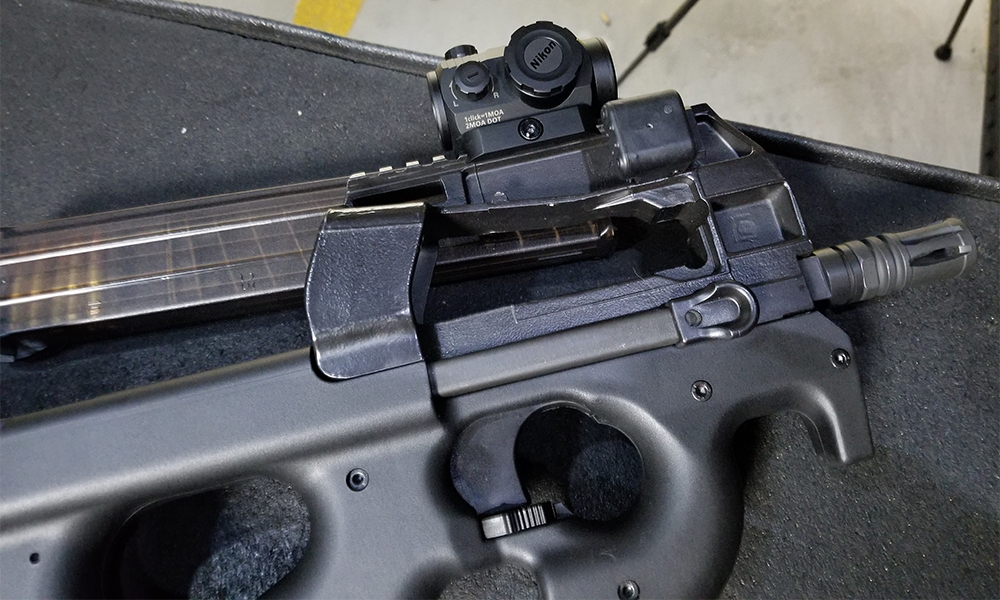
As I ran rounds down range, I noticed again how clear the targets appeared in the lower light of down range. The glass quality and clarity make it easy to transition from target to target and get quick follow up shots on each. I liked the tube style construction for this rifle as opposed to an open face such as the Nikon SPUR because of how exposed the optic was on top of the FN. It’s all aluminum construction and recessed glass would offer better protection for the red dot. The 2 MOA dot was perfect for getting solid groups at 15 yards onto 4” targets.
Colt AR SBR Platform
To go with something closer to traditional use, I mounted the SuperDot to my Colt AR platform SBR chambered in 9mm. Due to the A2 iron sight, I needed to use the co-witness pedestal to the SuperDot’s mounting plate. This placed the optic in the perfect position to run the rifle with and without the iron sights as well. This would be a great warm up for the testing to come afterwards.
The SuperDot was spot on with the 9mm rounds at the 10 – 20 yard mark and very easy to track through the optic as rounds landed on target. With the heavier rifle and light recoiling round, there was zero muzzle rise and I could actually see glints of light reflecting off the full metal jacketed rounds as they went down range at the 20 yard mark. Again, the tube style design of the SuperDot seemed to be more comfortable and easier to stay on target easier further down range than that of the open-faced optics I previously tested.
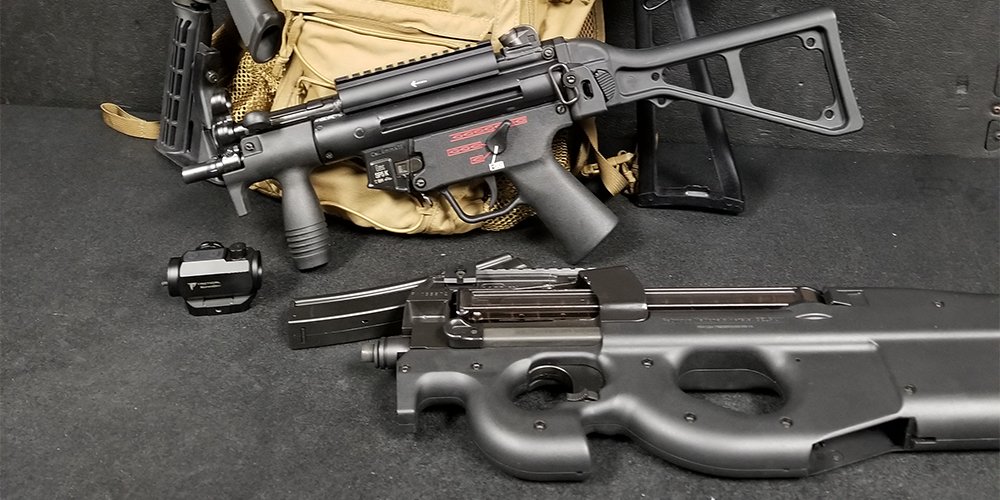
Pistol Caliber AR SBR
To heat up the last round of the indoor testing session, RSO Brandon Adkins and I mounted the SuperDot atop another pistol caliber AR short barrel rifle, this time in .45 ACP with full auto capability. As Brandon and I took turns running rounds through the suppressed AR, the SuperDot held strong. It gave me a clear view down range on target and helped me track shots as the rifle riddled paper terrorist down range. Despite the rough jarring of dumping 32 rounds down range in less than 3 seconds, the optic continued to track well and hold zero.
Outdoor Testing
The test session would see a change of venue to the infamous private training grounds known as “The Swamp.” Here, not only did the SuperDot see more testing on the previous firearms used, but also mounted on the ultimate combat shotgun, the Benelli M4 12 gauge. The Picatinny rail and low sights allowed for the optic to mount low for a great height over bore ratio.
The 2 MOA dot appeared clear and easy to see at the 7th setting in the outdoor setting. (Later this would be adjusted down a couple of clicks to the 5th setting as the rain clouds moved in.) Having the red dot mounted on the shotgun helped pin point my shot patterns faster and easier at longer distances out to 25 yards. Using both traditional 9 pellet 00 buck shot and as well as birdshot, the optic was unaffected by the rough recoil and fast cyclic rate of the Benelli. Even with the hotter specialized Federal Tactical loads that kept buck shot patterns under a 25” spread at 30 yards, the SuperDot performed great.
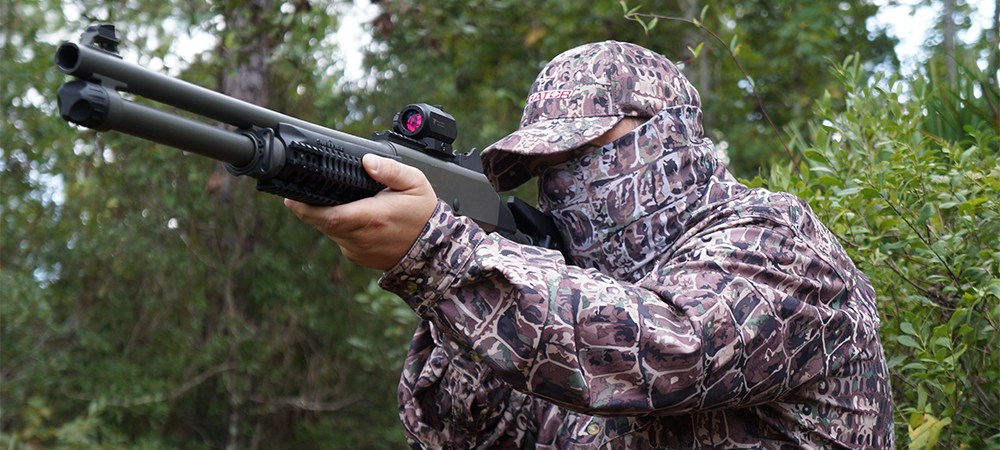
Over the extended time I tested the Nikon Super Dot, I do not recall ever actually turning the unit off. By the time you switch out the mounts and sight in various firearms with it for testing, the last thing on my mind at the end of each session was to turn it off. Nikon claims the battery life on the optic is approximately 14,000 hours on its lowest setting. Average setting used was 5 or 6 when switching between all lighting conditions tested in. When I was finally done, the last video clips were edited, and the optic was boxed and ready to ship, the reticle was still bright and clear. Come to think of it, did I turn it off before shipping the unit back to Nikon? Something tells me, they will still have a bright red dot waiting when the receive the Super Dot back to their marketing department. I was very impressed by this compared to constantly replacing batteries in my personal optics regularly.
Final Thoughts
Overall, I enjoyed my time with the Nikon SuperDot red dot sight. I was able to successfully use the optic on a wide variety of firearms without any major issues other than needed to retighten the mount once during testing. If I had to complain about anything, it would be the mount was just a bit too long for me to be able to secure the Super Dot to my Desert Eagle .50 AE for testing. I mostly blame the oddly cut on the top rail of the pistol for this issue. With that obviously fun testing opportunity missed, I did however feel the SuperDot did get plenty of use to be able to form an educated opinion on the optic.
For the past three years, I have been regularly running the SPARC red dot by Vortex Optics which is in the same price range as the SuperDot. Both optics have just what I prefer in a red dot, easy to use controls, a good battery life and multiple mounting options. In the case of the Supe Dot, I found I preferred the top mounted brightness / On / Off buttons over the Vortex SPARC’s small side mounted buttons, the Nikon optic offered bigger buttons that were much easier to use when running the firearm with shooting gloves on.
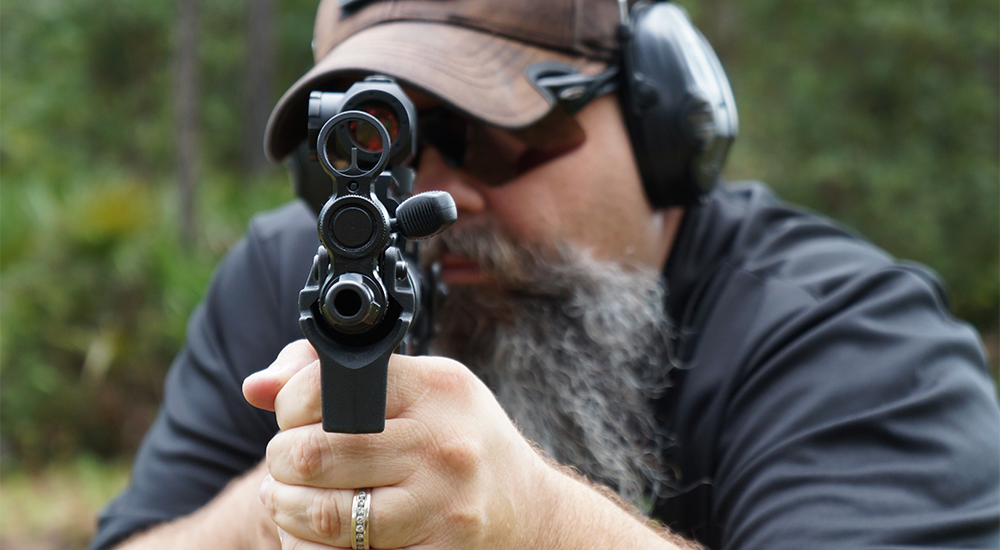
The adjustment screws were another plus as they are more accessible and quicker to zero each firearm. The caps used to cover the windage and adjustment screws doubled as the adjustment tool by having a straight ridge on the top which acted as a flat head screw driver to interface with the slot in each screw. This is an extremely handy feature when making adjustments in the field without tools or a dime in your pocket to fit in the slot.
Additionally, the 1 click = 1 MOA kept the math simple and straight forward without breaking out the slide ruler. This simple math may not mean a big deal to the average plinker, but when you are on the range using a red dot for close quarter training at 3 yards to 15 yards then switch to get shots on steel torso targets out to 200 yards, simple math keeps you in the game with faster hits that count rather than having to walk shots on target. With 100 MOA of available adjustments in both the windage and elevation, the Super Dot can cover a wide range of dialing in. Ultimately, I would like to see a finer tuning option such as 1 click = .5 MOA in the future from Nikon.
With a MSRP of $199, this is a solid red dot option for a lot of shooters not wishing to break the bank and have a very user-friendly optic to work with. The 5-year warranty is going to cover most of what the average shooter will encounter within that time frame as well as the comfort in having a reputable company such as Nikon backing their product. Special thanks to Tyler, Brandon and Wayland at On Target Sports for helping make this article another enjoyable day at work! Till next week, remember, a new product isn’t good to go until it’s been Swamp Tested and Swamp Reviewed!




Leave a Reply